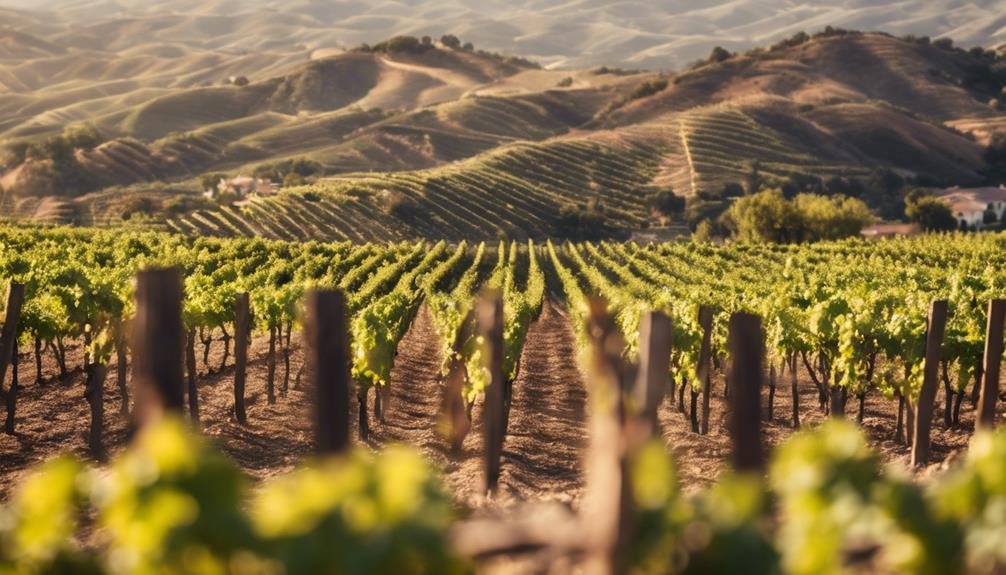Nestled between Buellton and Lompoc, Sta. Rita Hills AVA in California is renowned for producing exceptional cool-climate varietals. Its east-west orientation, influenced by sea breezes and fog, provides a longer growing season, leading to wines with crisp acidity and vibrant fruit profiles. The region's rich winemaking history dates back to the 1770s, with modern techniques elevating its status as an exciting Pinot Noir area. Distinctive minerality and salinity in the wines stem from the abundant diatomaceous earth-enriched soil. Notable producers like Brewer-Clifton and Sea Smoke showcase the region's potential. The legal dispute over the AVA name adds intrigue to this wine haven.
Sta. Rita Hills AVA Location
Nestled between the charming towns of Buelton and Lompoc in California, the Sta. Rita Hills AVA boasts a unique geographical position ideal for cultivating cool-climate varietals. The region's cool climate varietals thrive due to the east-west orientation, influenced by cool sea breezes and fog.
These unique terroir characteristics provide a longer growing season compared to other California regions, enhancing the development of flavors in the grapes. The Sta. Rita Hills AVA's proximity to the equator allows for the production of elegant wines, particularly notable for their crisp acidity and vibrant fruit profiles.
Winemakers in this AVA leverage these distinctive conditions to craft exceptional cool-climate varietals, making it a sought-after region for wine enthusiasts seeking quality and complexity in their wines.
Rich History of Winemaking
The storied heritage of winemaking in the Sta. Rita Hills AVA traces back centuries, reflecting a legacy of viticultural evolution and innovation.
- Missionary influence led to vine planting in the 1770s.
- Winemaking potential recognized in 1976 spurred modern techniques.
- Over the last 20 years, 2500 acres have been planted with modern trellising and vine clones.
- The AVA is emerging as an exciting Pinot Noir area.
- Modern techniques have elevated the quality of wines, showcasing the region's potential.
Soil Characteristics and Wine Quality

With an abundance of diatomaceous earth enriching the soil, Sta. Rita Hills cultivates wines known for their distinctive minerality and salinity, contributing to their exceptional quality. The unique soil composition, influenced by the presence of diatomaceous earth, plays a significant role in shaping the characteristics of wines produced in this region. This mineral-rich soil imparts a sense of minerality and salinity to the grapes, enhancing the flavor profile and overall complexity of the wines. The impact of diatomaceous earth on the wine quality is highly regarded by winemakers and wine enthusiasts alike, highlighting the importance of soil composition in the production of exceptional wines.
| Soil Characteristic | Influence on Wine Quality |
|---|---|
| Diatomaceous Earth | Imparts minerality and salinity |
| Excellent Drainage | Maintains acidity and fruit concentration |
| Unique Geological History | Contributes to overall wine quality |
Notable Wine Producers
Renowned for their exceptional wines, Sta. Rita Hills boasts a selection of notable wine producers recognized for their high-quality offerings. These producers not only focus on creating exquisite wines but also prioritize sustainability practices and meticulous vineyard management. Visitors to the region can experience the best of Sta. Rita Hills through wine tourism and by visiting the charming tasting rooms that many of these producers offer.
Here are five notable wine producers in the area:
- Brewer-Clifton: Known for their outstanding Chardonnay and Pinot Noir.
- Sea Smoke: Specializing in sought-after Pinot Noir with a unique ocean-influenced profile.
- Sanford Winery: A historic producer crafting elegant wines with a focus on sustainability.
- Foley Estates: Produces highly acclaimed Pinot Noir and Chardonnay wines.
- Melville Winery: Recognized for their exceptional cool-climate Syrah and Pinot Noir.
Legal Dispute and AVA Name

Fascinatingly, the AVA name 'Sta. Rita Hills' has been subject to a legal dispute involving a Chilean winery named Santa Rita. This controversy led to the retention of the abbreviation 'Sta.' in the official designation.
Despite the common colloquial reference to the AVA as 'Santa Rita,' the official name remains 'Sta. Rita Hills.' The involvement of the Chilean winery in the AVA naming controversy highlights the importance of intellectual property rights and the intricacies of geographical indications in the wine industry.
This legal battle underscores the significance of protecting regional identities and the complexities that can arise when entities with similar names operate in the same industry. The use of 'Sta.' in the AVA name serves as a reminder of the legal intricacies surrounding wine labeling and regional designations.
Frequently Asked Questions
How Do the Unique Geological Features of Sta. Rita Hills Influence Wine Quality?
The unique terroir of Sta. Rita Hills, with its abundance of diatomaceous earth, and microclimate influenced by cool sea breezes and fog, contribute to excellent drainage, minerality, salinity, acidity, and fruit concentration, enhancing the quality of wines produced in the region.
What Are the Key Factors That Make Sta. Rita Hills an Exciting Pinot Noir Area?
Sta. Rita Hills' allure as a Pinot Noir hub lies in its unique microclimates and commitment to sustainable practices. Factors like cool sea breezes, fog, and diverse soils create an ideal environment for producing exceptional wines.
Why Is There a Legal Dispute Over the AVA Name Involving a Chilean Winery?
The legal dispute involving a Chilean winery over the AVA name 'Sta. Rita Hills' stemmed from the use of 'Sta.' as a result of the winery's name, Santa Rita. Despite the lawsuit, the AVA continues to be recognized as 'Sta. Rita Hills.'
How Do the Soil Characteristics in Sta. Rita Hills Contribute to the Minerality in Wines?
The unique soil composition of Sta. Rita Hills, rich in diatomaceous earth, imparts minerality and salinity to wines. These characteristics, along with excellent drainage and geological history, contribute to wines with distinct flavor profiles and high quality.
What Modern Trellising and Vine Clones Are Commonly Used in Sta. Rita Hills Vineyards?
Modern viticulture in Sta. Rita Hills utilizes vertical shoot position trellising for canopy management. Popular vine clones include Dijon and Pommard for Pinot Noir, enhancing quality and consistency. These practices contribute to the region's reputation for exceptional wines.
Conclusion
To sum up, Sta. Rita Hills is not just a wine haven, but a veritable paradise for Pinot Noir enthusiasts. With its unique terroir, rich history, and exceptional wine producers, this AVA stands out as a premier destination for cool-climate varietals.
The enthralling journey of Sta. Rita Hills continues to unfold, offering wine lovers an unparalleled experience that is as thrilling as it is exquisite. Cheers to the enduring legacy of this remarkable wine region!
